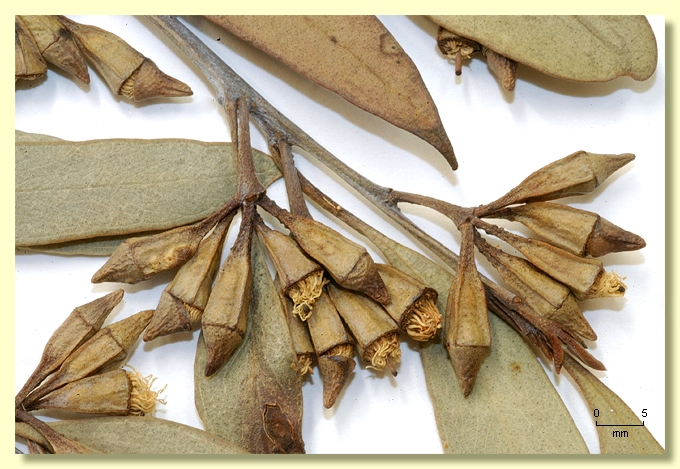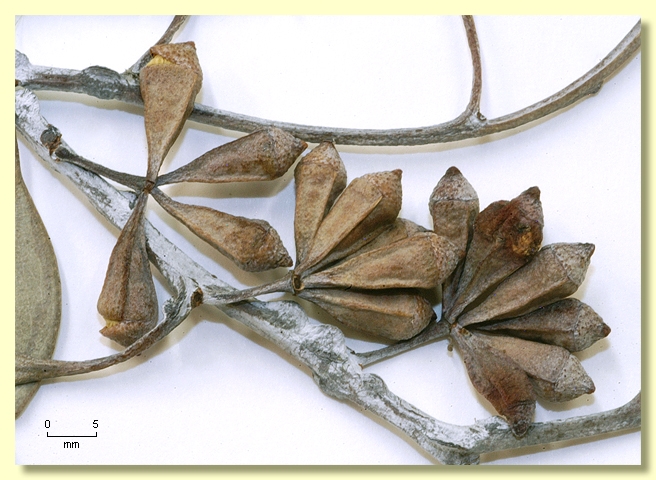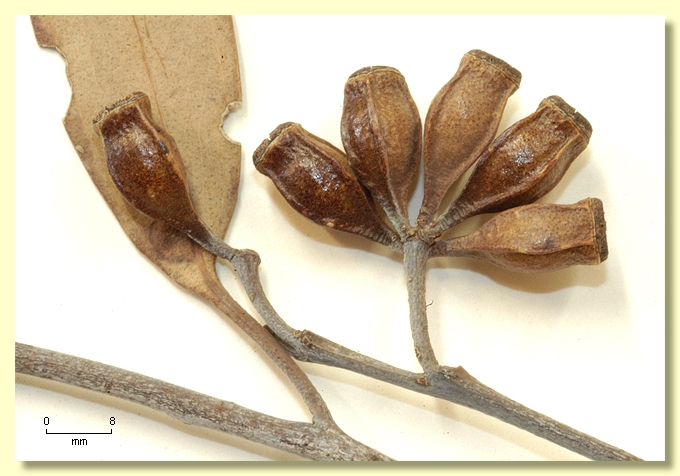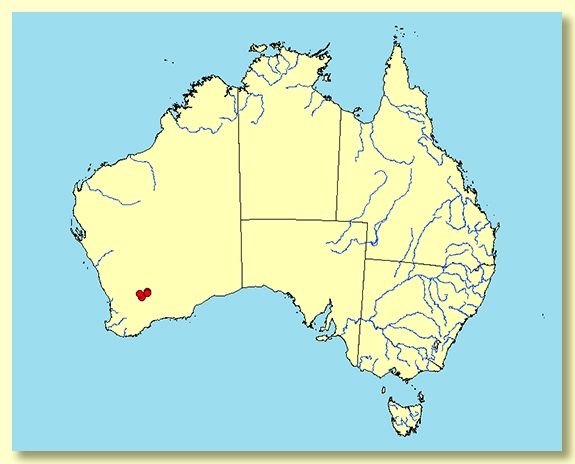Euclid - Online edition
Eucalyptus calycogona subsp. miraculum
Eucalyptus | Symphyomyrtus | Bisectae | Destitutae | Heterostemones
Mallee 3 m to 5 m tall. Forming a lignotuber.
Bark smooth throughout, shedding in ribbons, green-grey to dark grey over cream to pale tan.
Branchlets conspicuously glaucous; lacking oil glands in the pith.
Juvenile growth (coppice or field seedlings to 50 cm): not seen by us [data from Nicolle & French (2009)]; stems waxy; juvenile leaves shortly petiolate, opposite and slightly discolorous for a few nodes, becoming alternate, shortly petiolate, elliptic to ovate, to 4 cm long, to 1.8 cm wide, dull, blue-green or slightly waxy; new growing tips waxy.
Adult leaves alternate, petiole 1–1.8 cm long; blade lanceolate, 5.5–11.0 cm long, 0.8–2.2 cm wide, base tapering to petiole, concolorous, dull, glaucous weathering grey-green to dark green, side-veins very acute, moderately or sparsely reticulate, intramarginal vein parallel to and well removed from margin, oil glands island.
Inflorescence axillary unbranched, peduncles 0.6–1.2 cm long, buds 7 per umbel, pedicels 0.2–0.7 cm long. Mature buds oblong in outline and square in cross-section (0.8–1.2 cm long, 0.4–0.5 cm wide), glaucous, with 4 longitudinal ribs/angles, scar present (outer operculum shed early), inner operculum conical to pyramidal (ca 0.3–0.4 cm long), stamens all inflexed with the longer outer filaments also flexed tangentially in bud, the outer stamens lacking anthers (staminodes), the shorter inner stamens with anthers sub-versatile, more or less basifixed, oblong to reniform, dehiscing by subterminal pores, style long, stigma blunt or conical, locules 4, the placentae each with 4 clear vertical ovule rows. Flowers white.
Fruit pedicellate (pedicels 0.3–0.7 cm long), square in cross-section and more or less oblong in outline, 0.8–1.3 cm long, 0.5–0.8 cm wide, with 4 longitudinal ribs/angles, disc descending, valves 3 or 4, deeply enclosed.
Seeds mid-brown, 0.8-1.5 mm long, ovoid to flattened-ovoid, dorsal surface smooth, hilum ventral.
Cultivated seedlings (measured at node 10): not grown yet.
Flowering has been recorded in September and October.
Eucalyptus calycogona is a mallee species widespread in the mallee scrubs of southern Australia from the southern wheatbelt of Western Australia, through southern South Australia, north-western Victoria and just crossing the Murray River into New South Wales; usually on loamy rather than sandy soils. It is notable among the mallees for the buds and fruit, which are square in cross-section with 4 prominent ribs/angles and are longer than wide. Leaves are glossy green except in subsp. miracula which is conspicuously waxy.
Eucalyptus calycogona belongs in Eucalyptus subgenus Symphyomyrtus section Bisectae subsection Destitutae because buds have two opercula the outer of which sheds early, cotyledons are Y-shaped and branchlets lack oil glands in the pith. Within this subsection E. calycogona is one of seven closely related species that form series Heterostemones, the other species being E. quadrans, E. prolixa, E. gracilis, E. yilgarnensis, E. brevipes and E. celastroides. This group is characterised by the barren outer stamens that are conspicuously twisted and spreading in flower and the much shorter fertile inner stamens that are held more erect in flower. The species in this group also have narrow fruit with a descending disc and enclosed valves while the leaves have side-veins very acute at the base of the lamina and usually sparse reticulation.
In series Heterostemones E. calycogona, E. quadrans and E. prolixa have buds and fruit distinctly square in cross-section and differ from E. gracilis, E. yilgarnensis and E. brevipes, which have buds and fruit rounded in cross-section. E. celastroides has slightly angled buds but generally rounded fruit.
E. calycogona has longer, narrower buds and fruit than E. quadrans. Both are mallee species whereas E. prolixa is a tree (mallet) with fruit often longer than E. calycogona.
There are four subspecies:
E. calycogona subsp. calycogona
Smooth-barked with buds, fruit and adult leaves smaller than those of subsp. spaffordii. It is similar to subsp. miracula but is never white-waxy. Found in the southern and central wheatbelt areas of Western Australia from Wandering and Doodlakine east and south-east to Lake Grace and Esperance, extending through the southern edge of the goldfields almost to Balladonia and south to the Mt Ragged area. In South Australia it occurs on the northern and central Eyre Peninsula, northern Yorke Peninsula and eastern Fleurieu Peninsula.
It is also scattered through the Murray Mallee areas from South Australia into the Wimmera and mallee areas of Victoria as far east as about Boort, areas where subsp. trachybasis is much more common.
E. calycogona subsp. miraculum
Smooth-barked mallees with consistently glaucous branchlets, and glaucous crown leaves, buds and young fruit. Juvenile growth is also at least slightly glaucous on the new tips and stems. In other respects it matches subsp. calycogona. Confined to the area south-west of Marvel Loch in Western Australia extending west to Dulyalbin and Muntadgin. It was first collected by George Chippendale in 1968 but only recently described.
E. calycogona subsp. spaffordii
Smooth-barked mallees with buds and fruits usually somewhat larger than the other subspecies and strongly 'square' such that the corners are slightly winged. Restricted to the central Eyre Peninsula of South Australia around Cummins and in the Koppio Hills, south of the distribution of subsp. calycogona .
E. calycogona subsp. trachybasis
Differs from subsp. calycogona only in the presence of rough box-type to tessellated bark on lower trunk. This is the common form of the species in mallee areas of Victoria and the Murray Mallee of South Australia, and the only form found in New South Wales where restricted to the area around Koraleigh, north-east of Swan Hill. Young plants regenerating from lignotubers may flower before rough bark develops and are indistinguishable from subsp. calycogona at this stage.
Eucalyptus calycogona: Greek kalyx, calyx and -gonia, angled, referring to the four-sided buds and fruits.
subsp. miraculum: from Latin miracula, meaning marvel, referring to the location of the subspecies in the Marvel Loch area of Western Australia; also references the long time between the first collections (1968) and time of description in 2009.









